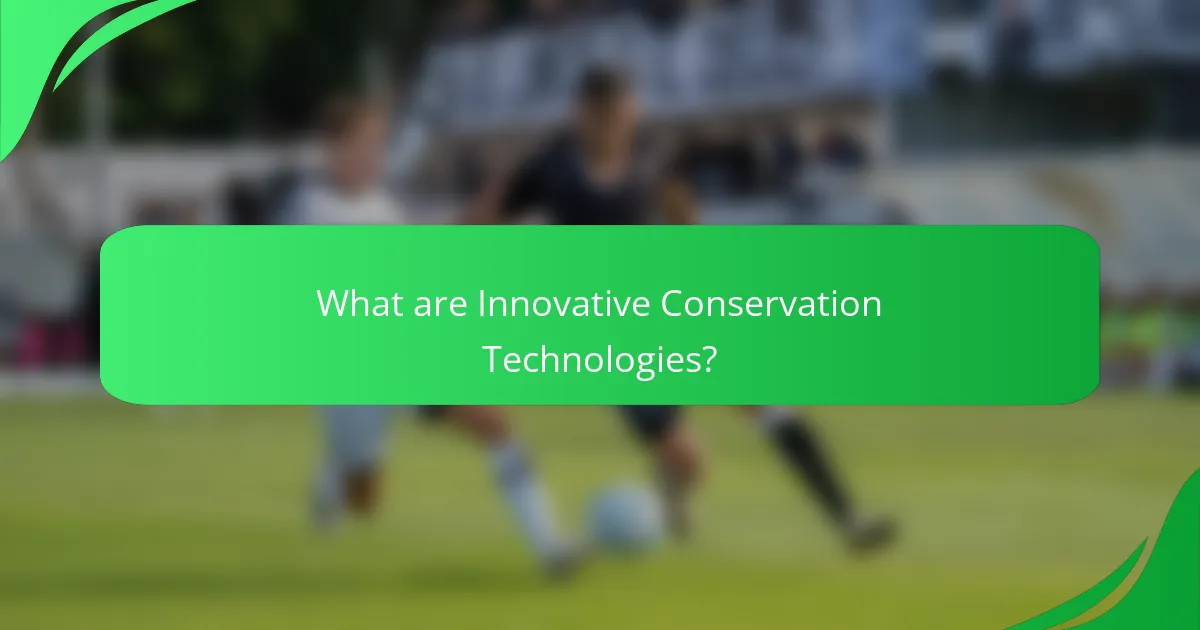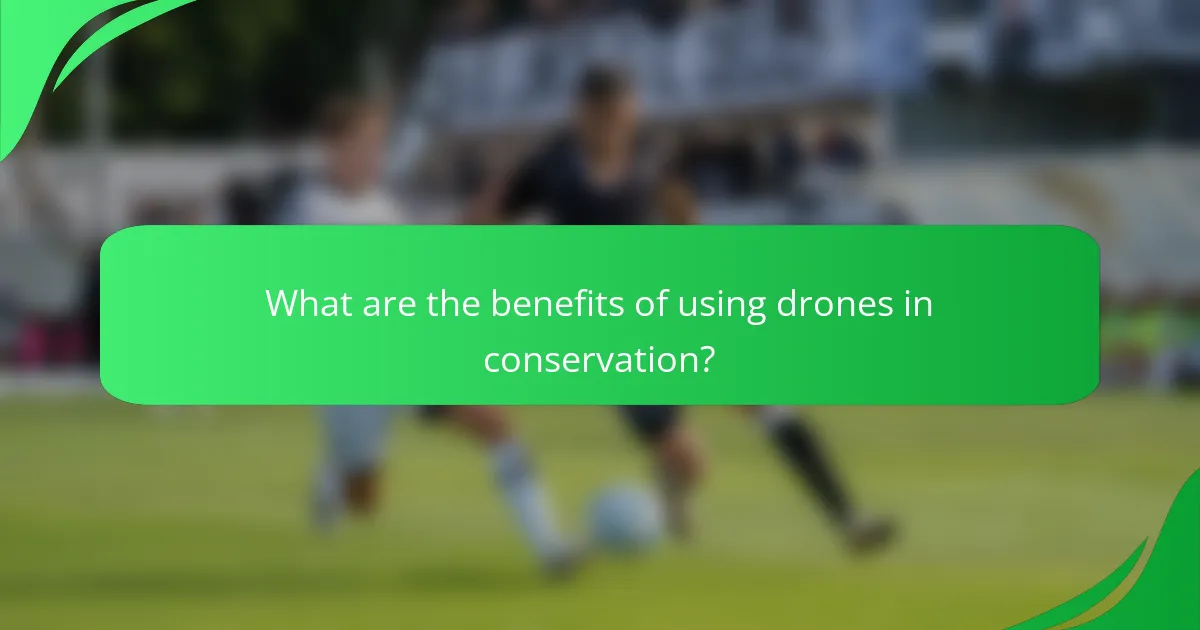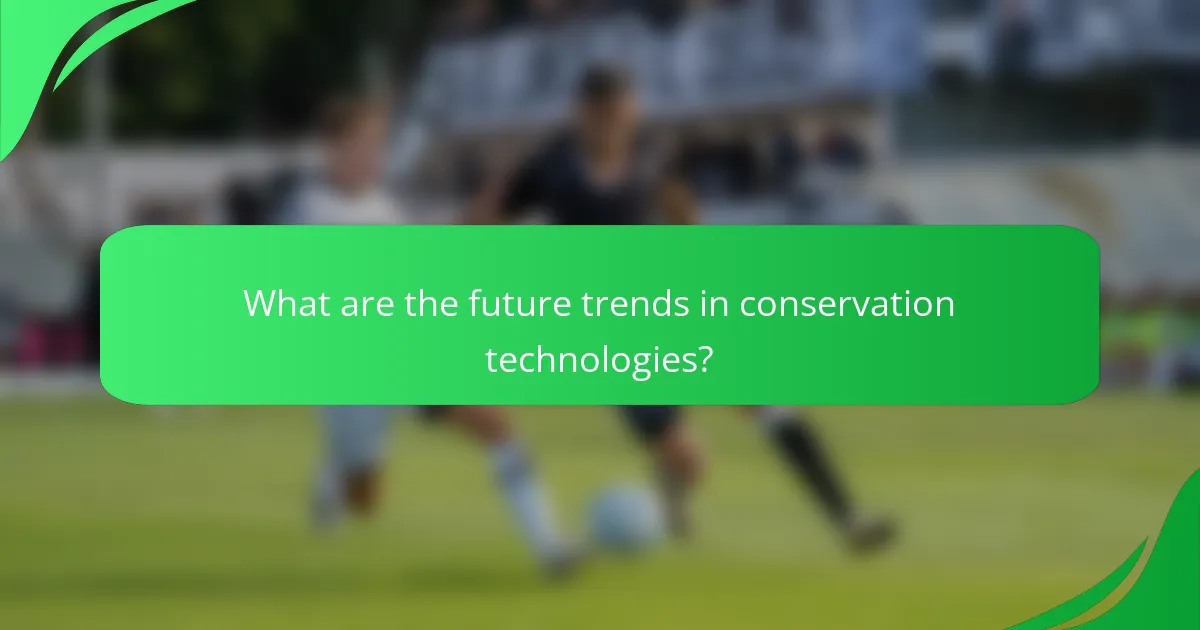Innovative conservation technologies are advanced tools and methods aimed at protecting and managing natural resources, with a focus on drones, remote sensing, and data analytics. Drones facilitate aerial surveys and wildlife monitoring, significantly enhancing efficiency by reducing time and costs associated with traditional methods. Remote sensing technology tracks habitat changes and assesses ecosystem health, while data analytics processes extensive datasets to identify trends that inform conservation strategies. Future trends indicate an increased reliance on these technologies, including the integration of satellite technology and IoT devices for continuous data collection, ultimately improving the effectiveness of wildlife protection efforts.

What are Innovative Conservation Technologies?
Innovative conservation technologies are advanced tools and methods designed to protect and manage natural resources. These technologies include drones, remote sensing, and data analytics. Drones are used for aerial surveys and monitoring wildlife populations. Remote sensing technology helps in tracking habitat changes and assessing ecosystem health. Data analytics processes large datasets to identify trends and inform conservation strategies. These technologies enhance the efficiency and effectiveness of conservation efforts. For example, studies show that drones can reduce the time needed for wildlife monitoring by up to 80%.
How do drones contribute to wildlife protection?
Drones contribute to wildlife protection by enabling efficient monitoring and data collection. They provide aerial surveillance of habitats that are difficult to access. This technology helps track animal movements and populations. Drones can identify poaching activities in real-time. They are equipped with high-resolution cameras for detailed imagery. This imagery aids in habitat assessment and environmental changes. Studies show drones reduce the cost of wildlife monitoring significantly. For example, a study by Anderson and Gaston (2013) demonstrated that drone surveys were more cost-effective than traditional methods.
What specific tasks can drones perform in conservation efforts?
Drones can perform various specific tasks in conservation efforts. They are used for wildlife monitoring and tracking. Drones capture high-resolution images to assess animal populations. They assist in habitat mapping by providing detailed aerial views. Drones also monitor environmental changes over time. They help in anti-poaching efforts by surveying remote areas. Drones can deliver supplies to inaccessible regions for conservation teams. They collect data on vegetation health and biodiversity. Drones enhance research efficiency by covering large areas quickly.
How do drones enhance data collection in wildlife monitoring?
Drones enhance data collection in wildlife monitoring by providing high-resolution aerial imagery and real-time data. They enable researchers to survey large areas quickly and efficiently. Drones can access remote or difficult terrains that are challenging for ground teams. This capability reduces human disturbance to wildlife, allowing for more accurate observations. Advanced sensors on drones can capture various data types, including thermal imaging and multispectral data. According to a study published in “Remote Sensing,” drones can improve species identification accuracy by 90% compared to traditional methods. The ability to collect data frequently allows for better tracking of wildlife populations over time. Overall, drones significantly increase the efficiency and effectiveness of wildlife monitoring efforts.
What role does data analytics play in conservation?
Data analytics plays a crucial role in conservation by enabling informed decision-making. It helps identify trends and patterns in wildlife populations. This information can guide conservation strategies effectively. For example, data analytics can track animal movements and habitat usage. It can also assess the impact of environmental changes on species. In 2021, a study showed that data analytics improved the effectiveness of anti-poaching efforts by 30%. By analyzing large datasets, conservationists can allocate resources more efficiently. This leads to better protection of endangered species and habitats.
How can data analytics improve decision-making in wildlife protection?
Data analytics can significantly enhance decision-making in wildlife protection by providing actionable insights from complex data sets. It enables conservationists to analyze patterns in animal behavior, habitat use, and poaching incidents. By processing large volumes of data from various sources, such as satellite imagery and field sensors, analytics can identify critical habitats and migration routes.
For example, a study by the World Wildlife Fund found that data analytics helped reduce poaching rates by 30% in certain regions. Predictive models can forecast potential threats, allowing proactive measures to be implemented. Additionally, data analytics supports the evaluation of conservation strategies by measuring their effectiveness over time.
This evidence demonstrates that data analytics is a powerful tool for informed decision-making in wildlife conservation efforts.
What types of data are most valuable for conservation analytics?
Spatial data is most valuable for conservation analytics. This includes Geographic Information System (GIS) data and satellite imagery. These data types help in mapping habitats and tracking changes over time. Species distribution data is also crucial. It provides insights into population dynamics and habitat use. Environmental data, such as climate and land use, informs about ecosystem health. Additionally, remote sensing data aids in monitoring deforestation and habitat loss. Collectively, these data types enhance decision-making in conservation efforts. They enable targeted interventions to protect endangered species and ecosystems.
Why is the integration of drones and data analytics important?
The integration of drones and data analytics is important for enhancing wildlife protection efforts. Drones provide high-resolution aerial imagery and real-time data collection. This technology allows for monitoring of wildlife populations and habitats from inaccessible areas. Data analytics processes this information to identify trends and patterns in animal behavior and habitat use.
According to a study published in the journal “Remote Sensing,” drones can cover large areas quickly, improving data collection efficiency by up to 80%. This efficiency enables conservationists to respond rapidly to threats such as poaching or habitat destruction. Additionally, combining drone data with analytics aids in predictive modeling, helping to forecast future wildlife movements and population changes.
These insights are crucial for making informed management decisions in conservation strategies. Ultimately, the synergy between drones and data analytics significantly enhances the effectiveness of wildlife protection initiatives.
How does this integration lead to more effective conservation strategies?
The integration of drones and data analytics leads to more effective conservation strategies by enhancing monitoring capabilities. Drones provide aerial surveillance, allowing for real-time data collection over large areas. This technology enables conservationists to track wildlife movements and habitat changes efficiently. Data analytics process this information, identifying patterns that inform decision-making. For instance, analyzing migration routes can help in creating protected areas. Studies show that drone-assisted monitoring increases detection rates of poaching activities by up to 70%. This integration ultimately leads to more informed, timely interventions in conservation efforts.
What challenges do conservationists face when integrating these technologies?
Conservationists face several challenges when integrating innovative technologies like drones and data analytics. High costs of technology can limit accessibility for many conservation projects. Additionally, technical expertise is often required to operate and maintain these technologies effectively. Data management and analysis can also pose difficulties, as large datasets generated need skilled personnel to interpret them. Furthermore, regulatory hurdles may restrict the use of certain technologies in protected areas. Resistance from local communities can arise due to concerns about privacy or disruption to wildlife. Lastly, ensuring data accuracy and reliability remains a significant challenge, impacting decision-making processes in conservation efforts.

What are the benefits of using drones in conservation?
Drones offer numerous benefits in conservation efforts. They provide aerial surveillance that is less intrusive than traditional methods. Drones can access remote areas that are difficult for humans to reach. This capability allows for real-time monitoring of wildlife and habitats. They can collect high-resolution images and data efficiently. Studies show that drones improve data accuracy and reduce costs associated with conservation projects. For instance, a study by Anderson and Gaston (2013) found that drones can reduce the time needed for wildlife surveys by up to 90%. Additionally, drones can be equipped with various sensors to monitor environmental changes. This technology enables conservationists to make informed decisions based on accurate data.
How do drones improve efficiency in wildlife monitoring?
Drones improve efficiency in wildlife monitoring by providing aerial data collection and real-time observations. They cover large areas quickly, reducing the time required for traditional ground surveys. Drones can access remote or difficult terrains where human presence is challenging. They capture high-resolution images and videos, enhancing data accuracy. This technology allows for monitoring of animal populations and behaviors without disturbing wildlife. Studies show that drone surveys can be up to five times faster than ground surveys. Additionally, drones can be equipped with thermal imaging to detect animals at night. This capability increases the chances of monitoring elusive or endangered species effectively.
What are the cost implications of using drones versus traditional methods?
Using drones typically reduces costs compared to traditional methods. Drones can cover large areas quickly, minimizing labor costs. For example, aerial surveys with drones can be completed in hours rather than days. This efficiency translates into lower operational expenses.
Additionally, drones reduce the need for expensive equipment like helicopters. According to a study by the University of California, drone surveys can cost up to 80% less than manned aircraft.
In terms of data collection, drones provide high-resolution imagery at a fraction of the cost of traditional methods. This cost-effectiveness makes drones a viable option for wildlife protection initiatives.
How do drones enhance safety for conservation teams?
Drones enhance safety for conservation teams by providing aerial surveillance and reducing human risk. They can monitor wildlife and habitats from a distance. This minimizes the need for teams to enter potentially dangerous areas. Drones can cover large areas quickly, allowing for efficient data collection. They also help in detecting poachers and illegal activities without direct confrontation. Research indicates that drone technology can significantly reduce the risks associated with fieldwork. Studies show that using drones leads to safer operations in remote or hazardous environments.
What environmental impacts can drones help mitigate?
Drones can help mitigate several environmental impacts, including habitat destruction, wildlife poaching, and pollution monitoring. They provide aerial surveillance for monitoring deforestation, allowing for timely intervention. Drones can also track wildlife movements, reducing human-wildlife conflict and aiding in conservation efforts. In anti-poaching initiatives, drones enhance surveillance over vast areas, improving law enforcement’s effectiveness. Additionally, drones are used for assessing air and water quality, identifying pollution sources. Studies have shown that drone technology significantly increases the efficiency of environmental monitoring programs. For instance, a report by the World Wildlife Fund highlights drones’ role in protecting endangered species through real-time data collection.
How can drones assist in habitat restoration efforts?
Drones can assist in habitat restoration efforts by providing aerial monitoring and data collection. They can capture high-resolution images and videos of ecosystems. This data helps identify areas needing restoration. Drones can also facilitate the planting of seeds in hard-to-reach areas. They can deliver seeds quickly and efficiently over large landscapes. Research shows that drone-assisted seed dispersal can increase reforestation success rates. For example, a study published in “Nature” demonstrated that drones effectively spread seeds in deforested regions. This method is faster and often more cost-effective than traditional planting methods. Drones enhance the overall efficiency of habitat restoration projects.
What role do drones play in tracking endangered species?
Drones play a crucial role in tracking endangered species by providing aerial surveillance and data collection. They enable researchers to monitor wildlife populations in real-time without disturbing their habitats. Drones can cover large areas quickly, which is essential for tracking species in remote locations. They are equipped with high-resolution cameras and sensors to capture detailed images and data. This technology allows for the identification of individual animals and their behaviors. Studies have shown that drones can significantly improve the accuracy of population estimates. For example, a study published in “Ecological Applications” demonstrated that drones could count penguin populations more accurately than traditional methods. Overall, drones enhance the effectiveness of conservation efforts by providing critical information for protecting endangered species.

What are the future trends in conservation technologies?
Future trends in conservation technologies include the increased use of drones and data analytics. Drones enable real-time monitoring of wildlife and habitats. They can cover vast areas quickly and collect high-resolution images. Data analytics helps in processing this information efficiently. Machine learning algorithms can identify patterns in animal behavior. This enhances decision-making for conservation efforts. Additionally, satellite technology is becoming more prevalent for tracking environmental changes. The integration of IoT devices allows for continuous data collection in remote areas. These advancements aim to improve the effectiveness of conservation strategies.
How is artificial intelligence shaping wildlife protection efforts?
Artificial intelligence is significantly enhancing wildlife protection efforts. AI technologies improve data analysis for monitoring animal populations. They enable real-time tracking of endangered species. Machine learning algorithms can predict poaching activities based on historical data. Drones equipped with AI can survey large areas efficiently. These drones collect high-resolution images for habitat assessment. AI also assists in identifying species through image recognition. This technology reduces human error in wildlife identification. Overall, AI streamlines conservation strategies and improves response times to threats.
What advancements in drone technology are expected in the coming years?
Advancements in drone technology expected in the coming years include improved flight times and payload capacities. Manufacturers are developing drones with longer battery life, enabling extended missions. Enhanced sensors will provide better data collection capabilities for environmental monitoring. AI integration will allow for real-time data analysis and decision-making. Increased automation will enable drones to perform complex tasks with minimal human intervention. Regulatory changes are anticipated to facilitate expanded commercial use of drones. Enhanced communication systems will improve connectivity and data transmission. These advancements will significantly impact wildlife protection efforts by enabling more efficient monitoring and data gathering.
How can predictive analytics change the landscape of conservation?
Predictive analytics can significantly enhance conservation efforts by enabling data-driven decision-making. This approach uses historical data to forecast future trends in wildlife populations and habitat conditions. For example, machine learning algorithms can analyze patterns in animal movements, helping to identify critical habitats and migration routes.
Additionally, predictive models can assess the impact of climate change on ecosystems, allowing for proactive measures to protect vulnerable species. According to a study published in the journal “Ecological Applications,” predictive analytics has improved the accuracy of species distribution models by over 30%. This increased precision aids conservationists in allocating resources more effectively.
Furthermore, predictive analytics can optimize anti-poaching strategies by predicting potential poaching hotspots based on historical data. This targeted approach can lead to more efficient patrols and resource management. Overall, the integration of predictive analytics into conservation strategies represents a transformative shift towards more effective and sustainable wildlife protection.
What best practices should conservationists follow when utilizing these technologies?
Conservationists should prioritize ethical considerations when utilizing innovative technologies. They must ensure that the deployment of drones and data analytics does not disturb wildlife or disrupt natural habitats. Training is crucial; personnel should be well-versed in the technology’s capabilities and limitations. Regular data validation ensures accuracy in analytics, which is vital for effective decision-making. Collaboration with local communities fosters trust and enhances conservation efforts. Additionally, conservationists should maintain transparency in their operations to promote accountability. Adhering to legal regulations protects both the environment and the integrity of conservation initiatives. These practices collectively enhance the effectiveness and sustainability of conservation technologies.
How can organizations ensure ethical use of drones in wildlife protection?
Organizations can ensure ethical use of drones in wildlife protection by implementing strict guidelines and regulations. These guidelines should include obtaining necessary permits and adhering to local wildlife protection laws. Training drone operators on ethical practices is essential. Operators must understand the impact of their actions on wildlife. Regular assessments of drone operations can help identify and mitigate negative effects. Engaging with local communities fosters transparency and accountability. Collaboration with conservation experts ensures that drone use aligns with conservation goals. Monitoring drone data helps evaluate the effectiveness of wildlife protection efforts.
What are the key considerations for data privacy in conservation analytics?
Key considerations for data privacy in conservation analytics include informed consent, data anonymization, and secure data storage. Informed consent ensures that individuals understand how their data will be used. This is critical when collecting data in sensitive areas or from local communities. Data anonymization protects the identity of individuals by removing personally identifiable information. This practice helps mitigate risks associated with data breaches. Secure data storage involves using encryption and access controls to protect sensitive information from unauthorized access. These measures are essential for maintaining trust and compliance with privacy regulations. For instance, the General Data Protection Regulation (GDPR) mandates strict guidelines for data handling in the European Union.
Innovative conservation technologies encompass advanced tools and methods, primarily focusing on drones and data analytics, aimed at protecting and managing natural resources. Drones facilitate efficient wildlife monitoring, habitat assessment, and anti-poaching efforts through real-time aerial surveillance and high-resolution imagery, significantly enhancing data collection and reducing costs. Data analytics plays a crucial role in informing conservation strategies by processing large datasets to identify trends and optimize resource allocation for wildlife protection. The integration of these technologies leads to more effective conservation strategies, although challenges such as high costs and data management persist. The article will explore the benefits, challenges, and future trends associated with these innovative technologies in wildlife conservation.